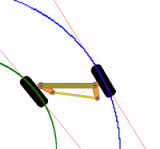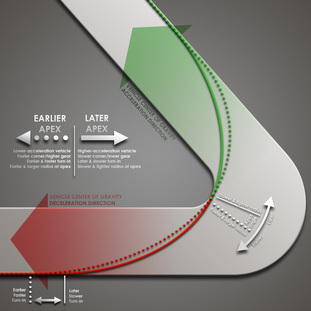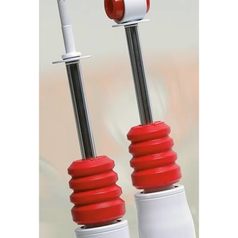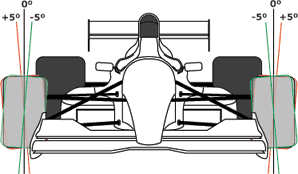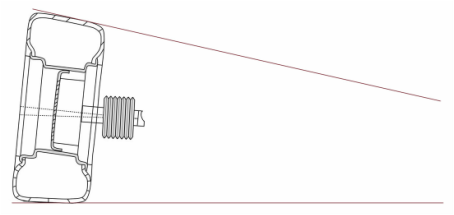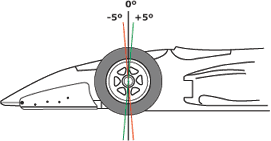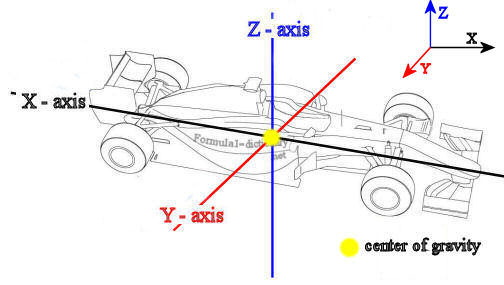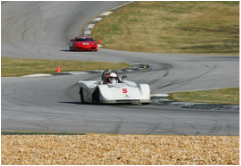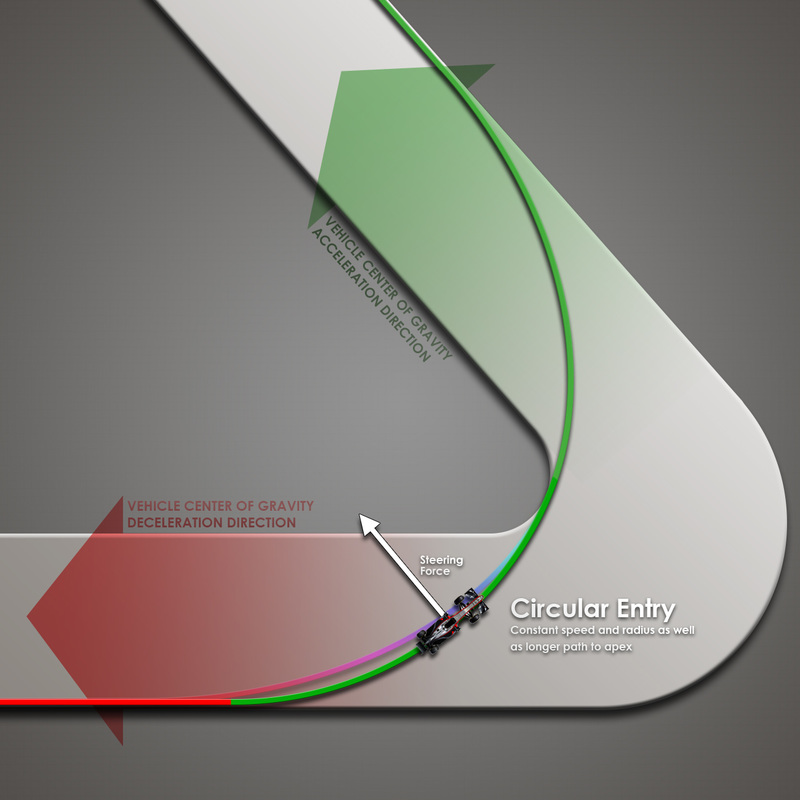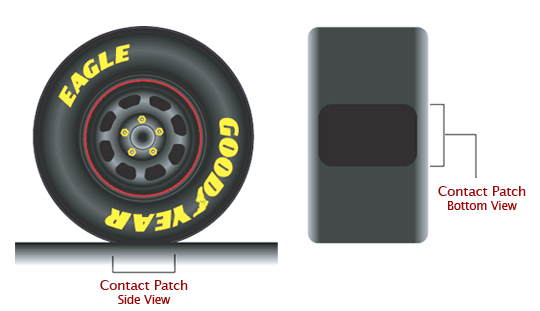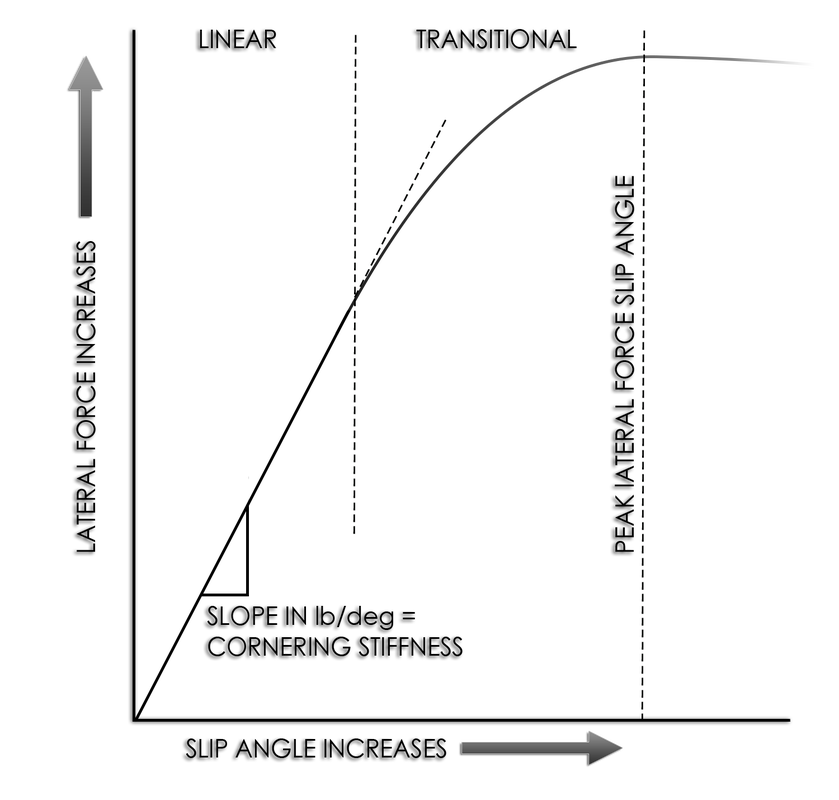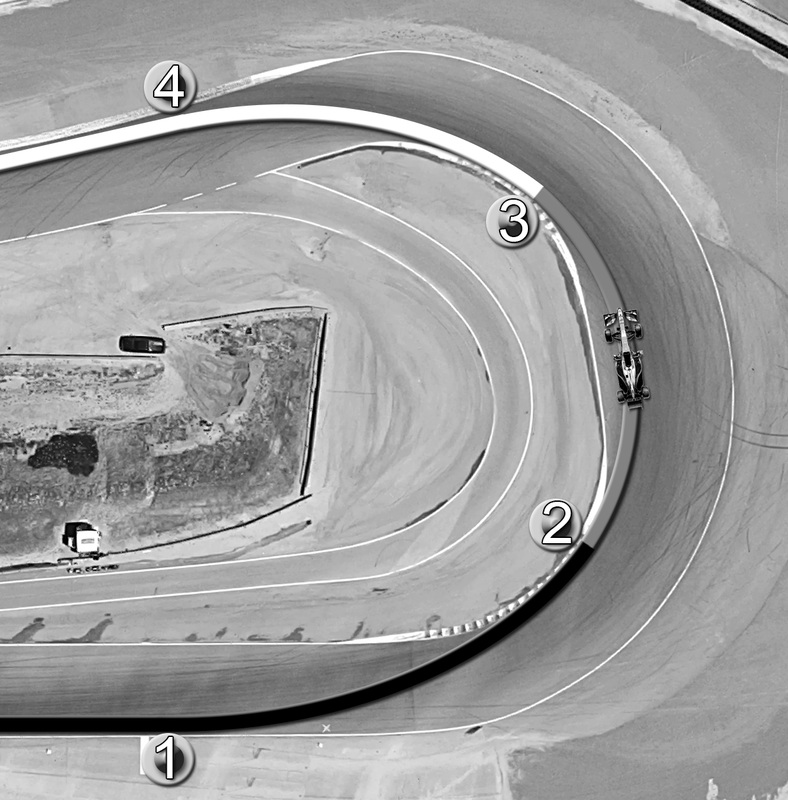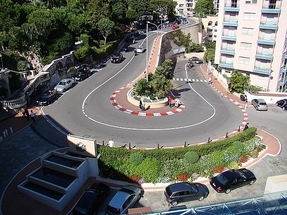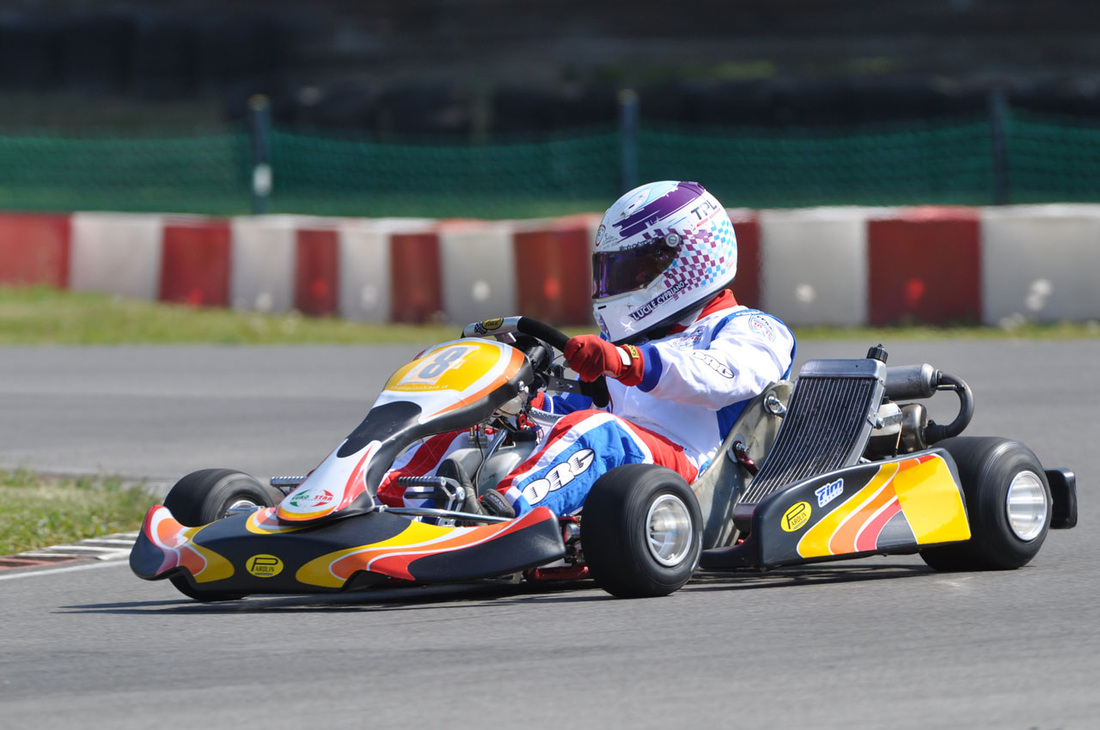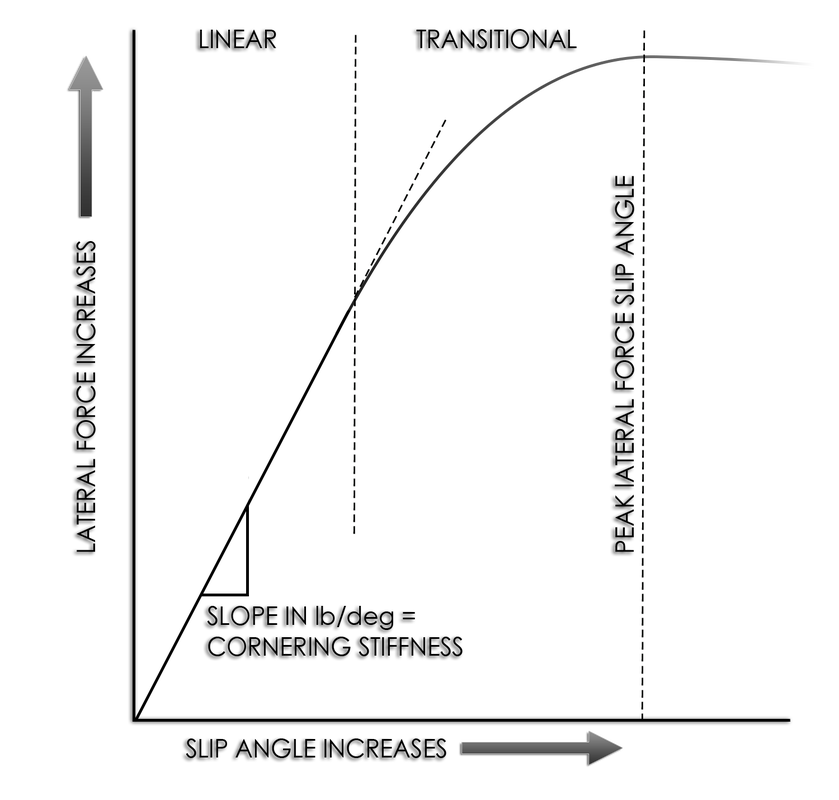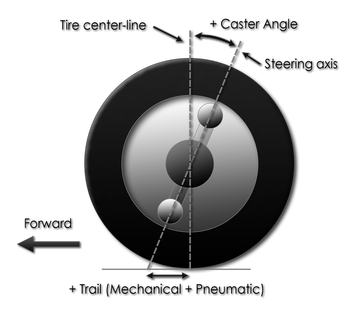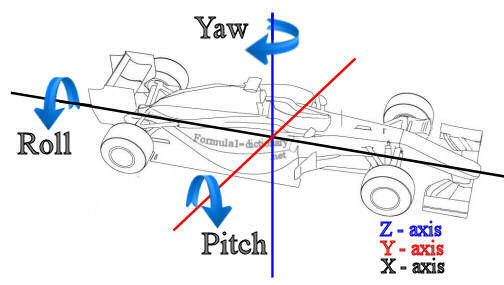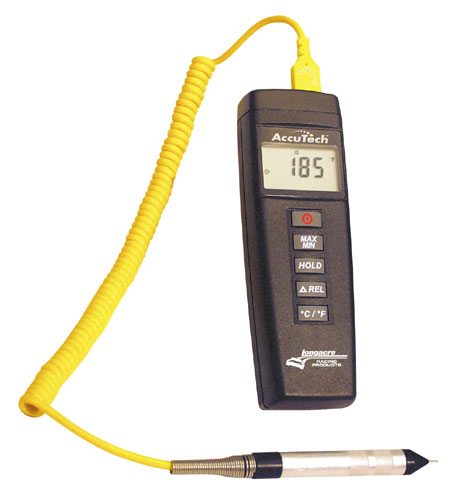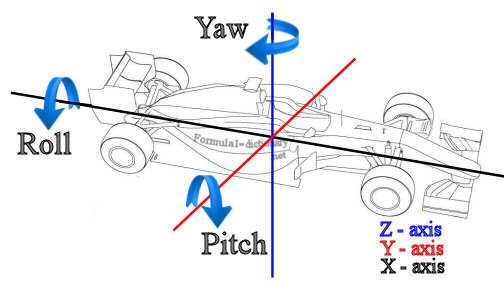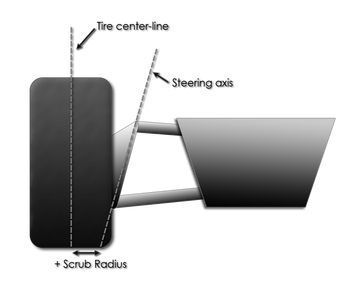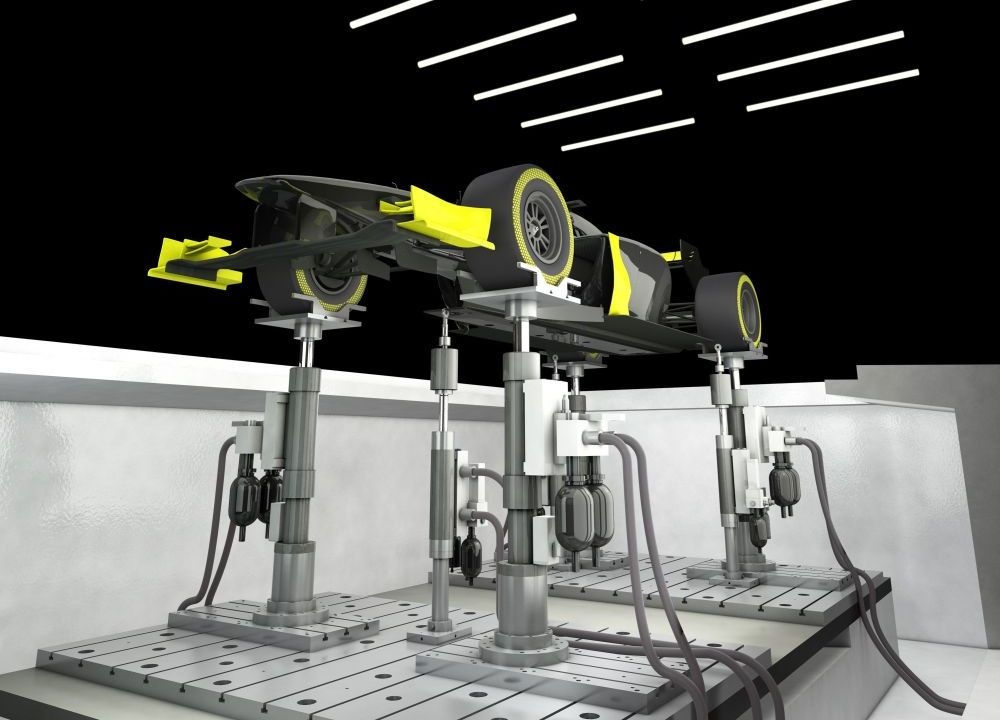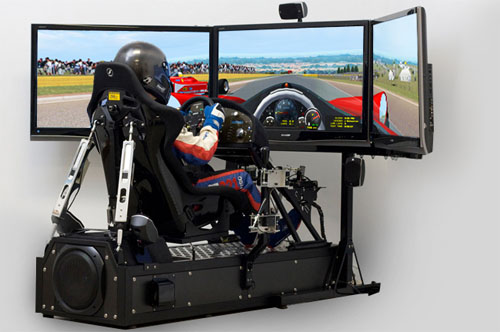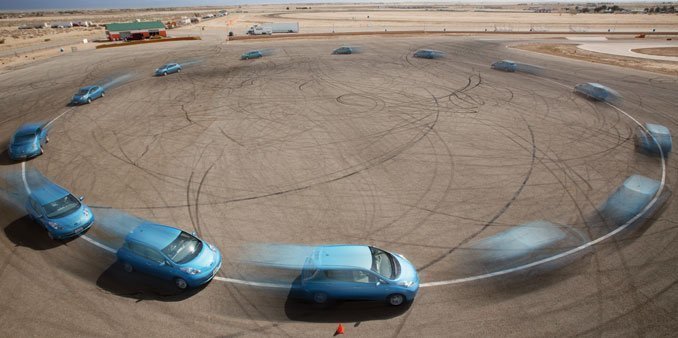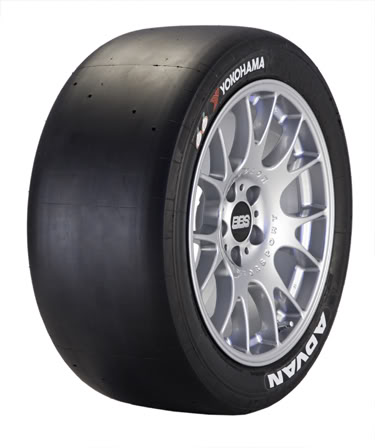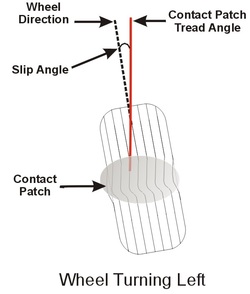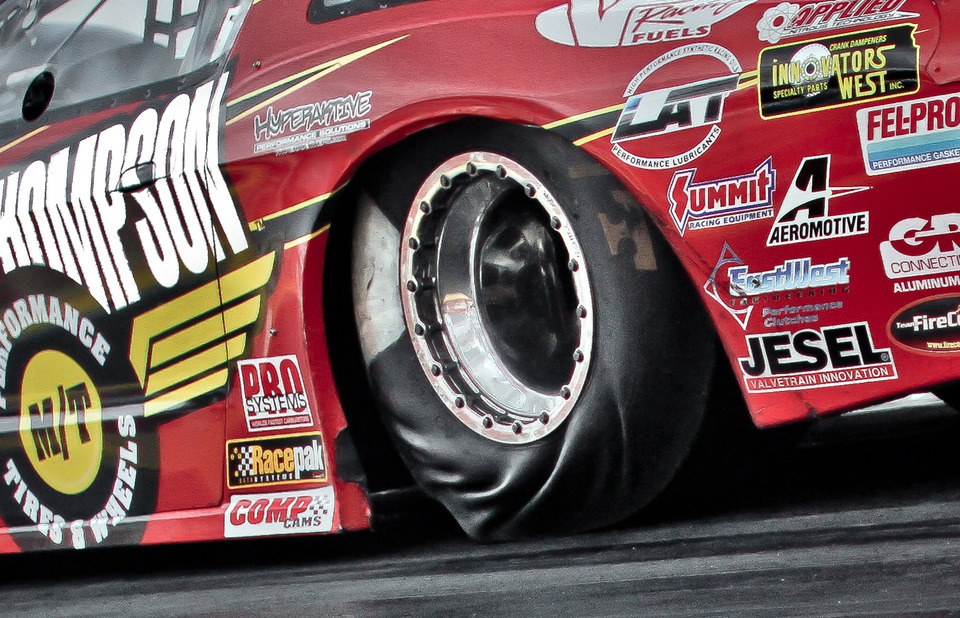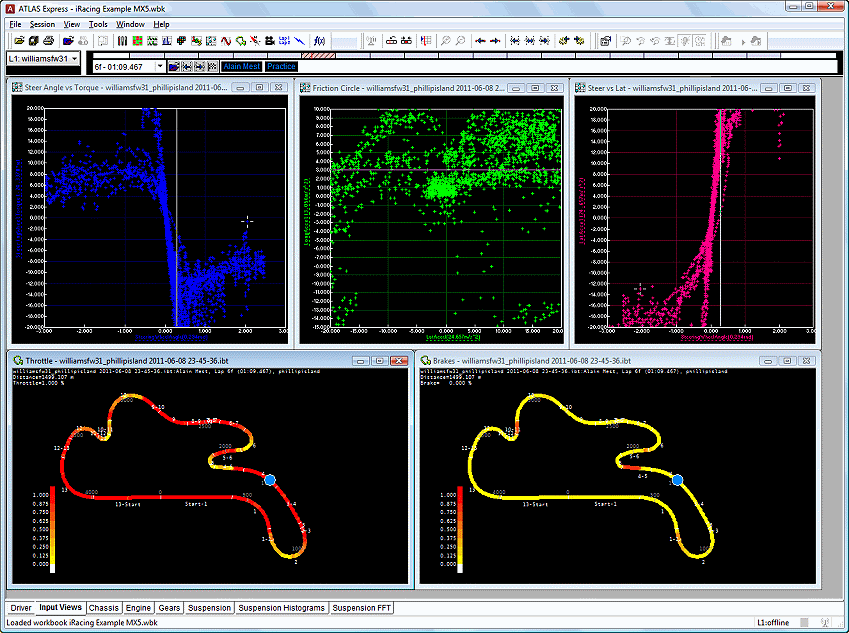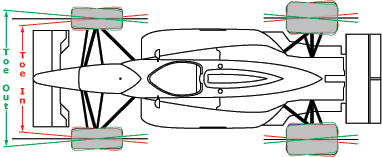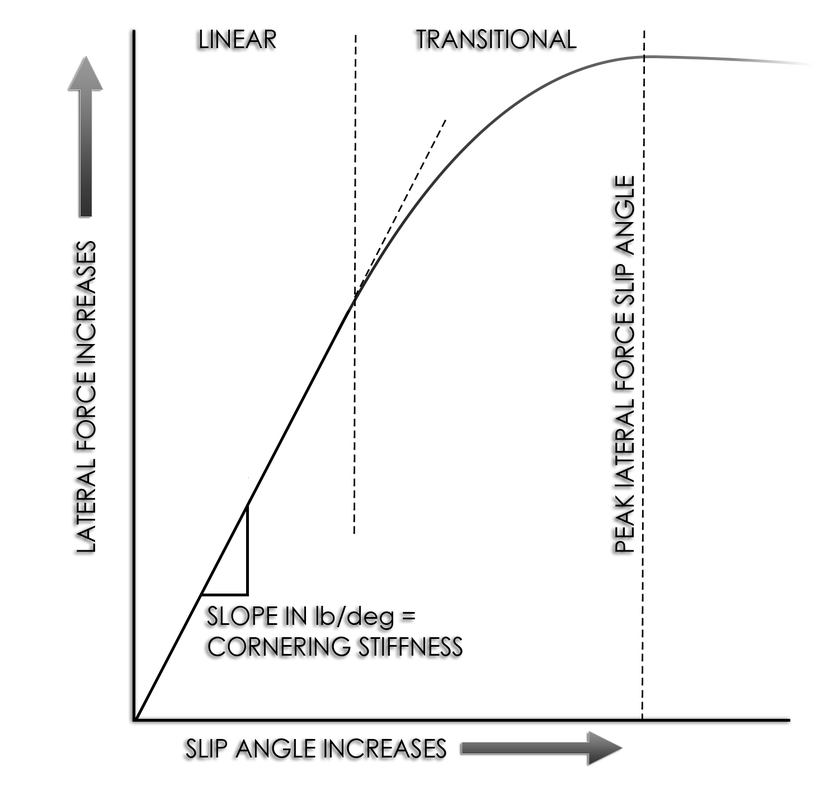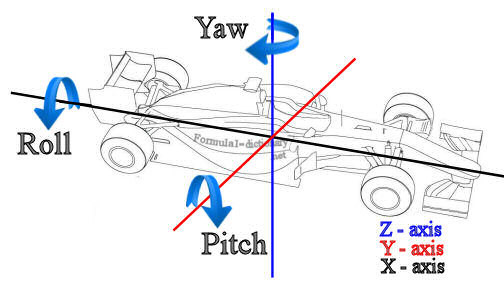ackerman Steering
| A steering geometry design that allows the toe angle of the front tires to change dynamically as the steering wheel turns with the standard setup being an increase in negative toe with an increase in steering. This was originally developed to minimize tire scrub as during a turn the inner and outer tire must travel on different size circles, but variations on the basic principle have been used in motorsports in an attempt to increase performance. This is rarely directly adjustable on most cars and is primarily a consideration during the design phase, but many karts allow easy adjustments of ackerman steering. |
alignment
Adjusting a vehicles suspension to alter how the tires are situated in relation to the chassis and each other. The primary adjustments being camber, caster, toe. These settings can be adjusted to improve performance, tire wear, and alter handling characteristics.
anti-roll bar
Anti-roll bars are part of a car's suspension system. They are sometimes also called anti-sway bars or stabilizer bars. Due to the way they are designed and mounted, unlike the primary suspension springs they increase a car's stiffness in roll, but not in ride. They are generally designed to be a relatively easy adjustment to make and are typically the primary way to adjust a car's balance. Some more advanced race cars even have cockpit adjustable anti-roll bars.
apexIn basic terms, the apex or clipping point is the point on the inside portion of a corner that a vehicle passes closest too. The apex can also be described as the point of minimum radius and slowest speed achieved in a corner. An apex can be defined as being an earlier apex or later apex. An earlier apex will reach the inside of a corner at a higher speed and with a larger radius than a later apex |
autocrossAutocross (also called "Gymkhana", "Solo", "Auto-x" or "Autoslalom") is a timed competition in which drivers navigate through a defined course typically marked by cones in a large open paved area. Autocross differs from road racing and oval racing in that generally there is only one car on the track, racing against the clock rather than directly with other cars. |
balance
Car balance describes the tendency of a car either toward oversteer or understeer. For example, a normal street car would be described as having a balance that is more biased toward understeer.
brake bias
Indicated as a percentage. This indicates the relative amount of brake pressure applied to the front brakes. E.g. 52% would indicate that the front brakes were receiving 52% of the brake pressure and the rear brakes would be receiving 48%. Brake bias is often adjustable from the cockpit in many race cars and is generally used to maximize braking potential and control vehicle balance while using the brakes.
bumpsteer
Bump steer or roll steer is the term for the tendency of the tires of a car to steer by themselves as the suspension travels through it's range of motion. This is generally seen as a negative and minimizing any bump steer is typically seen as ideal.
camber
| The camber angle identifies how far the tire slants away from vertical when viewed directly from the front or back of the vehicle. Camber is expressed in degrees, and is said to be negative when the top of the tire tilts inward toward the center of the vehicle and positive when the top leans away from the center of the vehicle. |
camber gain
Camber gain is the difference of the camber angle after a certain amount of suspension travel. This is usually defined based on 1" of suspension compression. For example if static camber is -3 degrees and goes to -4.5 degrees at 1" compression, it has -1.5 degree camber gain.
Camber Thrust
When a wheel has some amount of camber, the deflection in the tire makes it act as a cone rolling across the ground which creates a force in the direction the tire is leaned.
car control
The ability of a driver to control a car at the limits of the tires and car performance.
caster
| The caster angle identifies the forward or backward slope of a line drawn through the upper and lower steering pivot points when viewed directly from the side of the vehicle. Caster is expressed in degrees and is measured by comparing a line running through the steering system's upper and lower pivot points to a line drawn perpendicular to the ground. Caster is said to be positive if the line slopes towards the rear of the vehicle at the top, and negative if the line slopes towards the front. |
Center of Gravity
| The center of gravity is a geometric property of any object. The center of gravity is the average location of the weight of an object. For a vehicle this is the point from which all forces created at the tires react too. It can be described as a certain point in the vehicle on an X, Y, Z coordinate. If you suspended a vehicle from this point it would rotate in all directions freely. A car's weight distribution is often described by its center of gravity location. For example, a 60% rearward center of gravity would describe a car with 60% of it's weight on the rear tires and 40% on the front. |
coastdown test
A test that measures the total aerodynamic drag, tire rolling resistance, and driveline friction of a car. It is performed by bringing a car to a certain high speed and then pushing in the clutch and recording the time it takes to reach a given lower speed or measuring the reduction in speed over a given time.
Corner Weight
The practice of adjusting a vehicle's suspension to distribute the weight among the tires. The ideal can differ based on goals whether it be even loading or increased load on two tires and less on the other two. This is also known as cross weight, or wedge. Corner weight may also refer to the actual weight measured at each individual tire on the car.
damper
A part of a car's suspension designed to reduce oscillations and modify the dynamic movement of the car. Also known as a shock absorber. Race-oriented dampers may have separate adjustment for compression (bump) and extension (rebound.) They may also further split the adjustments into high-speed for controlling the fast suspension movement over bumps, and low-speed, which affects the relatively slower suspension movements caused by driver inputs.
Differential
The differential is designed to drive a pair of wheels while allowing them to rotate at different speeds. In vehicles without a differential, such as karts, both driving wheels are forced to rotate at the same speed. This hinders turning as the inside wheel must travel a shorter path than the outside. A kart must therefore lift the inside wheel to aid cornering.
Differential (limited-slip)
Limited slip differentials use various mechanisms to allow normal differential action during turns, while also solving the problem of slippage. When one powered tire slips, the LSD transfers more torque to the non-slipping wheel by partially or fully locking the two wheels together. Racing-oriented LSDs often allow different amounts of locking during acceleration and deceleration.
downforce
Downforce is a downwards thrust created by the aerodynamic characteristics of a car. The purpose of downforce is to allow a car to travel faster through a corner by increasing the vertical force on the tires, thus creating more grip.
FAUX CHICANE
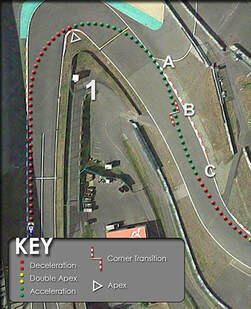
Faux Chicane is a term we use for a situation when a driver should still fully optimize a corner to the track edge, but either the entry or exit should not begin or end at that point.
In the illustration, the driver has "faux chicaned" the exit of turn 1 by still fully optimizing the exit to the edge of the track at A, but has continued to turn at the limit until point B when steering passes back over center and they drop below the limit.
What makes this different from a true chicane is that deceleration for turn 2 does not begin until point C. If deceleration were needed as soon as steering passes over center at B, this would be an actual chicane and the driver would not optimize the exit of 1 to edge of the track at A. They would instead need to optimize the apexes of turn 1 and 2 together.
As a final note, Faux Chicane is simply a shorthand term we use for a common situation when dealing with the physics of optimizing straights as discussed in Perfect Corner 2. Theoretically, all entries and exits should be "faux chicaned" but most straightaways are long enough to make the extra angle negligible. You can find more info about Faux Chicanes in the Lime Rock Track Notes as well.
In the illustration, the driver has "faux chicaned" the exit of turn 1 by still fully optimizing the exit to the edge of the track at A, but has continued to turn at the limit until point B when steering passes back over center and they drop below the limit.
What makes this different from a true chicane is that deceleration for turn 2 does not begin until point C. If deceleration were needed as soon as steering passes over center at B, this would be an actual chicane and the driver would not optimize the exit of 1 to edge of the track at A. They would instead need to optimize the apexes of turn 1 and 2 together.
As a final note, Faux Chicane is simply a shorthand term we use for a common situation when dealing with the physics of optimizing straights as discussed in Perfect Corner 2. Theoretically, all entries and exits should be "faux chicaned" but most straightaways are long enough to make the extra angle negligible. You can find more info about Faux Chicanes in the Lime Rock Track Notes as well.
kartingKart racing or karting is a variant of open-wheel motorsport with small, open, four-wheeled vehicles called karts, go-karts, or gearbox/shifter karts depending on the design. They are usually raced on scaled-down circuits. Karting is commonly perceived as the stepping stone to the higher ranks of motorsports. |
Left-foot braking
Using the left foot to operate the brake pedal. Left-foot braking is required in certain vehicles such as karts, but many drivers choose left-foot braking in vehicles that would allow standard right-foot braking. These drivers may also incorporate switch-foot or throttle-braking.
limit (the)
The maximum speed a car can attain while turning before a car begins to either oversteer or understeer excessively.
mechanical trailMechanical trail is the perpendicular distance between the steering axis and the point of contact between the front tire and the ground. Past the design process, the amount can typically only be modified by altering caster. An increase in caster will increase mechanical trail which increases the force trying to center the steering wheel. This felt force increase comes from the greater distance between the steering axis and the contact patch causing a greater torque on the steering system. So although the force felt at the steering wheel is greater, the force at the tire remains the same. |
Motion Ratio
Motion ratio in suspension of a vehicle describes the amount of damper/spring travel for a given amount of wheel travel. Mathematically it is the ratio of spring travel to wheel travel. Often the wheel will travel a greater distance than the spring as the suspension compresses and extends. This reduces the effective wheel rate.
oversteer
In the simplest terms this is when the rear tires exceed their limit before the front tires while negotiating a turn. This is an unstable condition that can lead to a spin.
pitch
pneumatic trail
Pneumatic trail is caused by the progressive build-up of lateral force along the length of the contact patch, such that lateral forces are greater towards the rear of the contact patch and this creates a torque on the tire called the self aligning torque. For most tires, pneumatic trail will increase as the tire approaches its peak traction and thus increase steering force, but prior to actually reaching the peak the pneumatic trail will reduce due to sliding at the rear of the contact patch. Pneumatic trail is primarily important because of its effect on steering forces. Together with mechanical trail they are called total trail.
pyrometer (Tire)A tool used to measure temperature. For racing this is typically used to measure the temperature of the tire tread by using a probe style pyrometer and inserting the probe directly into the surface of the tire. A common practice is to take the measurement across the face of the tire in three different places from the inside, middle, and outside. |
Rake
Rake refers to the angle that the body of a car has in relation to the ground. It is typically measured as the distance from the lowest point on the body to the ground at the front and rear of the car. Positive rake is when the rear of the car is higher in the front. Negative rake is when the front of the car is higher than the rear. It is primarily important for aerodynamic reasons.
ride
Also known as heave, this is the up/down movement of the entire chassis of a car in response to it's movement on track or the suspension geometry reacting to tire forces. It is defined as up/down movement of the center of gravity of the chassis in relation to the tires.
ride height
This is the static or dynamic measure of a car chassis in relation to the ground. It is usually measured from the lowest points on the car that will make contact with the ground first if the ride height is too low.
roll
Roll center
There are many varying ways that engineers define a roll center, but essentially it is a result of the suspension geometry that alters handling in a similar fashion to adjusting anti-roll bars. A higher roll center at one end of the car will increase roll resistance there and vice-a-versa.
scrub radius
| The scrub radius is the distance in front view between the steering axis and the center of the contact patch of the wheel, where both would theoretically touch the road. If the steering axis intersection point is outboard of the center of the contact patch it is negative, if inside the contact patch it is positive. Large positive values of scrub radius, 4 inches/100 mm or so, were used in cars for many years. The advantage of this is that the tire rolls as the wheel is steered, which reduces the effort when parking. If the scrub radius is small then the contact patch is spun in place when parking, which takes a lot more effort. The advantage of a small scrub radius is that the steering becomes less sensitive to braking inputs, in particular. |
sector
Used in lap timing, a sector is any timed portion of a lap. Many times there will be 3-5 official sectors designated for a track, but for setup/training purposes a driver and team can set custom sectors using their own telemetry system.
sim racingSim (simulated) racing is the collective term for computer software (i.e. a vehicle simulation game) that attempts to accurately simulate auto racing (a racing video game), complete with real-world variables such as fuel usage, damage, tire wear and grip, and suspension settings. This can range from console based games using a gamepad to advanced full motion simulators. |
slickA racing slick (also known as a "slick tire") is a type of tire that has a smooth tread used mostly in auto racing. By eliminating any grooves cut into the tread, such tires provide the largest possible contact patch to the road, and maximize traction for any given tire dimension in dry conditions. Grooved tire tread only offers a grip advantage in wet or loose (gravel, dirt, snow) conditions. |
slip angleSlip angle or sideslip angle is the angle between a rolling wheel's actual direction of travel and the direction towards which it is pointing. All tires experience slip angle while turning because of the tire distorting with a "peak" slip angle achieved at maximum cornering force. Because of slip angle at the rear tires , a car will have a sideways attitude to the direction of travel while cornering at speed even if the tire is not sliding across the track. |
slip ratio
| The wheel speed divided by the actual speed of the vehicle. We can also measure the slip ratio as a percentage. e.g. a slip percentage of 10% means the tire is moving 10% faster/slower than the road surface. One important thing to remember is that the slip ratio is not the same as wheel spin. When acceleration/braking torque is applied to a tire the tire distorts and moves along the road without actually slipping, so a wheel can be moving faster/slower than the road without any wheel spin. |
Spring rate
Spring rate refers to the amount of weight it takes to compress a spring a certain distance. The higher the spring rate, the stiffer the spring.
steady-state handling
Steady-state handling refers to the handling characteristics of a car that is not currently undergoing significant suspension movement. Examples of this could be cornering at the limit or threshold braking. This is as opposed to transient handling.
Switch-foot braking
A left-foot braking technique where the driver will complete the heel-and-toe downshift using standard right-foot braking at which time they will switch to left-foot braking. This is most often used by drivers wishing to employ left-foot braking, but that must still use the left foot to operate the clutch.
telemetryTelemetry (or data acquisition) is the practice of collecting information during a test or race and using it to properly tune the car for optimum performance. Examples of measurements on a race car include accelerations (G forces) in three axes, temperature readings, wheel speed, and suspension displacement. Driver input is also recorded so the team can assess driver performance. |
Throttle-braking
A braking technique where the driver will combine the use of left-foot braking with throttle to dynamically control brake bias and remove engine braking. Greater throttle usage while braking will counteract the rear braking force and move the brake bias forward.
toe
| The toe angle identifies the exact direction the tires are pointed compared to the centerline of the vehicle when viewed from directly above. Toe is expressed in either degrees or fractions-of-an-inch, and an axle is said to have positive toe-in when imaginary lines running through the centerlines of the tires intersect in front of the vehicle and have negative toe-out when they diverge. |
Trail BrakingCombining steering with braking. Trail-braking provides a more optimized corner entry than traditional straight-line only braking by creating combined lateral and longitudinal forces through the tires. These combined forces cause the corner entry path to be of constantly reducing radius and speed as well as shorter than the traditional circular entry. |
transient handling
Transient handling refers to the handling characteristics of a car that is experiencing rapid suspension movement. An example of this could be the fast transition from one direction to the other in the middle of a chicane or a driver having to make a quick correction to avoid a spin. This is as opposed to steady-state handling.
understeer
In the simplest terms this is when the front tires exceed their limit before the rear tires while negotiating a turn. This is a stable condition as opposed to oversteer.
Wheel rate
Wheel rate is the spring rate but measured at the wheel instead of where the spring attaches to the chassis. It is the spring rate multiplied by the motion ratio squared.
wheelspin
When a tire begins to spin too fast because of excess power applied. This causes a reduction in acceleration.

